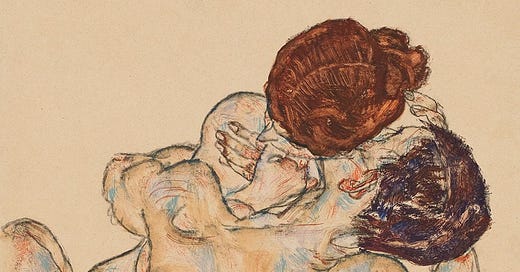The Intimacy Illusion
Reclaiming the sacred in an age obsessed with exposure - beyond, flesh, filters, and performance

Intimacy did not enter the world through declarations or treaties, but through gestures as old as breath. Before the invention of language, before we shaped syllables into tools of seduction or confession, there was a gaze held a second too long, the warmth of another body curled beside your own in the dark - wordless, primal, indispensable. Long before philosophers puzzled over the soul, the soul was already leaning, reaching, brushing against another in the dark of a cave, not out of lust, but of recognition. Intimacy began not as poetry, but as pulse: a subtle alignment of heartbeats in a moment when survival and tenderness became indistinguishable. It was not yet erotic, not yet romantic – it was the earliest form of “I know you”, uttered not through mouths, but through nearness, through the trust of sleeping side by side in a world still sharpened by danger.
As societies evolved, intimacy did not vanish but metamorphosed – wreathed in rituals, guarded by customs, refracted through the kaleidoscope of culture.
In Japan, where public restraint conceals oceans of private emotion, intimacy is a choreography of nuance: the selection of the right tea cup, the deliberate angle of a bow, the almost imperceptible shift in language between tatemae (public façade) and honne (true feelings). There, to share one’s unvarnished self is an act of grace, not spectacle.
In the Arab world, intimacy is both sacred and understated – woven into the fabric of language itself. The Arabic word for human, insān, derives from the root uns, which means intimacy, closeness, the warmth of being with another. To be human, in this linguistic lineage, is to be intimate by nature – to belong not in isolation, but in communion. And though Arab societies often emphasise modesty, boundaries, and public decorum, intimacy thrives in the private realm: in the cadence of a shared story over strong coffee, in the slow burn of trust across generations, in the unspoken solidarity of friendship that expects nothing and gives everything.
In Latin America, intimacy sings in the streets: it’s in the exuberant embrace, the shared food, the music that invades even grief.
The West, however, made intimacy bureaucratic, something to sign for, to negotiate, to perform. We engineered romance into a series of transactions and turned vulnerability into a market-tested brand. Each culture dresses intimacy in its own garments, but the soul beneath them always longs for the same thing: to be met without masks.
The great confusion of the modern age is not that we lack intimacy, but that we have misidentified it – mistaking it for sex, proximity, or exposure. We have reduced intimacy to the mere friction of flesh, as though the soul does not demand its own form of nakedness. What passes for closeness in the era of endless sharing is often a façade, a mimicry of revelation that demands no real risk. Intercourse without intimacy is theatre with no plot – motion without meaning. We bare our bodies before we have even considered baring our minds. And in doing so, we have confused penetration with presence, climax with communion. The digital age hasn’t killed intimacy; it has collapsed it into content. We no longer whisper our longings; we post them. We have traded the ineffable for the archivable.
We swipe through humans like catalogues, perform affection over dinner before the first bite, and curate vulnerability for likes. Connection has become a performance art, with intimacy as its most miscast role. Even when we speak of loneliness, we do it in memes – pre-packaged sorrow, safely ironic. The problem is not that people don’t want to connect, but that we have forgotten how to do so without surveillance. We record moments that are meant to be private, dilute the power of the unspoken, and think exposure equals closeness. But intimacy is not content. It withers when captured, recoils from applause. It is the anti-spectacle, the sacred pause, the presence that cannot be retweeted.

To be truly intimate is to be dangerously unarmed. It is to step into a space where your cleverness cannot protect you, where your prettiest metaphors fail, and you are asked not to perform, but to remain. Real intimacy is never slick. It is awkward, raw, and resists the script. It shows up in the unfinished sentences, the tear caught mid-smile, the silence that lingers because neither person wants to leave. It’s in the mundane, the ritual of ordinary things made extraordinary by who shares them with you: folding laundry together, cooking in parallel, falling asleep mid-conversation. Intimacy is not the plot twist, it is the slow-burn subplot you didn’t know you were invested in until the last page breaks your heart.
Some cultures intuitively understand this and hold space for the unspeakable dimensions of closeness. In India, the idea of samskara – a kind of spiritual imprint – means that every shared act, from eating to grieving, leaves a trace in the soul. In such a context, intimacy is not an event but a lifelong unfolding. Contrast this with the Western hunger for definitions, where relationships must be clarified, statused, and justified with linguistic rigour. We want boxes – friend, lover, partner, ex – as though the heart ever obeyed categories. But intimacy is inherently liminal; it dwells in in-betweens. It’s not the wedding ring but the glance across the room at a crowded party that says, without words: I know your exits, and you know mine.
Intimacy is not ownership, and it is not always reciprocal in the way we hope. You can feel deeply connected to someone who will never feel that with you. That doesn’t diminish the intimacy; it simply reveals its asymmetry. And you can be intimate with people without ever touching them - a mentor, a stranger whose story becomes part of your own, a friend with whom words are unnecessary. Western individualism, shaped by scarcity logic, insists intimacy is a scarce resource, something to be hoarded. But intimacy multiplies. It expands as it is shared. The soul, unlike the ego, is generous in its capacity for closeness.
This is where I step into the frame – not as narrator, but as a witness of my own wiring. For me, intimacy is not grand or gaudy, it is the soft architecture of presence. It lives in the details others miss but I never do: the breath someone takes before speaking a truth, the pause before laughter when they wonder if they are safe enough to let it go, the tremor in their fingers when they reach for their coffee and think no one sees. I always see. I live with my senses unsheathed, collecting these micro-revelations like others collect souvenirs. I don’t want to conquer someone’s body or even their biography; I want to trace the emotional scar tissue with the reverence of an archivist and the awe of a lover. I’m not drawn to surface seductions – I want the confessions made after midnight, the secrets tucked under sarcasm, the silences so raw they pulse. I’ve never been able to do small talk without tasting ash in my mouth. I don’t fall in love with faces; I fall for someone’s ability to stay when things get quiet. Intimacy, for me, isn’t a fuse that burns quickly, but a slow burn that softens my vigilance. I need the kind of closeness that allows me to stop translating myself. When I find it, I give everything. I reveal the hidden rooms, the locked drawers, the messy pages of my mind – and I expect to be met, not marvelled at. Because the truest intimacy, for me, is mutual recognition. Not the echo of my words, but the harmony of another soul who speaks the same dialect of depth.
And yes, intimacy is also political. In a culture addicted to surveillance and curation, to be genuinely close with someone – offline, unmonetised, unmarketed – is nothing short of radical. To whisper something sacred and never post about it. To exist in a moment that will not be archived. In an age of algorithmic voyeurism, to protect intimacy is to rebel against the commodification of connection. It is to choose presence over proof, attention over analytics. Intimacy cannot be datafied. It is the last wild, uncaptured thing. And it must be defended like a dwindling ecosystem.
To cultivate intimacy in the modern world is to remember how to move slowly. How to hold space instead of filling it. How to ask a question and wait, truly wait, for the unhurried answer. Read someone a book aloud. Cook them a meal without photographing it. Sit beside them in silence until it speaks. The rituals of intimacy are often small, repetitive, and invisible, but they are the rituals that stitch two inner worlds into a shared reality. Intimacy is not a series of dramatic declarations, but the accumulation of undramatic devotion.
Grief, too, is the shadow side of intimacy, the proof of how deeply we have been known and how difficult it is to be un-known. Every close connection we form is a gamble against absence. We grieve not just people, but the spaces they made sacred: the inside jokes that no longer land, the favourite seat at the table that now stings. But this grief is not a sign of failure. It’s proof that intimacy occurred. That something real, unreplicable, was created between two beings. That for a time, we stood outside the machinery of indifference and chose to matter to one another.

Children come into the world fluent in intimacy. They lean into their parents’ bodies, whisper to animals, reach for strangers with unfiltered longing. They are poets of presence, unburdened by irony. But we train them out of it. We tell them not to stare, not to cry, not to touch. We teach them to mask, to measure, to mute. Adulthood, then, becomes the art of forgetting and remembering: forgetting how we were taught to hide and remembering how we were born to connect. We don’t need more techniques, no, we need more trust in the simple, terrifying act of being real.
Even the most fleeting physical interactions can be charged with intimacy when they are rooted in awareness: the adjustment of a collar, the brushing away of an eyelash, the sigh shared between two people staring out the same window. These gestures are not decoration, they are declarations, disguised as ordinary. They form an invisible language, a dialect of attention that only the attuned can hear. Algorithms cannot replicate this no matter how intimate the tone, AI cannot look at you with recognition. It can mimic, but not mirror. Because intimacy is not mimicry. It is meaning. And meaning demands human risk.
Ultimately, the most challenging intimacy is the one we cultivate with ourselves. To sit alone and meet our own eyes without flinching. To know our hunger, our contradictions, our unbearable tenderness, and respond with compassion rather than contempt. Self-intimacy is not navel-gazing; it’s the soil from which all other closenessgrows. Without it, we are wanderers, seeking in others what we refuse to offer to ourselves. But with it, we become whole enough to offer – not need, not perform, but offer – our truth.
In the end, intimacy is not a luxury. It is not a footnote to love or a supplement to romance. It is the marrow of what makes us human. Without it, we become efficient but hollow, successful but unmoored. We scroll and swipe and speak, but we do not touch. To be intimate is to be implicated, to admit that we are porous, that we long to be known and to know in return. In this mad world of spectacle and speed, intimacy is the rarest revolt. And the most vital. Not an accessory to life, but its essence.
In reverence for the unspoken, and in defence of the unrecorded, still choosing presence over proof, and closeness over noise, with hands unarmed and heart ajar,
Tamara
P.S. this essay is dedicated to my friend, Wes





Tamara, your essay did more than speaking to me, it saw me. It’s rare that I read something that feels like a mirror held not to the face but to the soul’s quieter corners. You write of intimacy with the precision of a scholar and the ache of someone who has waited for it, longed for it, and perhaps had to learn to live without it more than once.
There’s a line I keep rereading: “To be truly intimate is to be dangerously unarmed.” That sentence alone cracked something open in me. It reminds me of how we armor ourselves against our own depth—out of fear that to reveal our rawness is to risk being too much, or worse, not enough.
And yet, what you add, this radical, unmarketed, anti-spectacle kind of presence, is exactly the kind of human connection I think we are all secretly starving for. In a world that demands clarity and speed, you honor the ambiguous, the liminal, the slow burn. You remind me that intimacy isn’t symmetrical, and that doesn’t mean it isn’t sacred. That nuance alone feels like a balm for all the relationships I’ve grieved without permission.
If I may add a thread to your tapestry: intimacy also asks us to live with the unanswered… silence, and ambiguity. The friend who never explains their sudden distance. The text that is never replied to. The love that bloomed but never rooted. True intimacy doesn’t guarantee clarity bur it demands we stay present even in uncertainty.
Your writing is an act of reclamation. Thank you for putting words to what so many of us have only ever felt in fragments. I walk away from this humbled. And hungry for less performance, and more presence.
I would like to move into this essay and stay there forever. That’s not very realistic, though, so instead I send it to everyone I know. Maybe that brings the world slightly closer to intimacy.